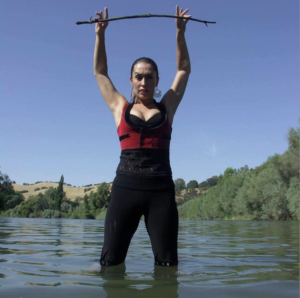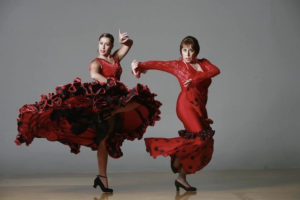Humbly carrying on a Gitano family flamenco legacy
I was 5 years old and it was “show and tell” day at my elementary school. I remember that day vividly because I was so excited to bring a little flamenco dancer doll and tell the class about mi mamá Carolina Lugo, a professional flamenco dancer, and how I liked to dance flamenco with my abuela (grandmother) too. It feels like it is all coming full circle now. There have been so many memorable things that have happened since, from performing professionally together for the majority of my life, to now, where mi mamá at a fairly young age (she is in her 60’s) is sick and unable to get out of bed.

![]()
![]()
Being the fifth generation flamenco and Spanish dancer in my family, this is the abridged version of our matriarchal familial story. We are Sephardic Jewish and Gitano, Spanish for Romani people, (we now say Romani people instead of the offensive “Gypsy” in English). As such, we were either killed or forced to leave Spain. So, my great–great–grandmother Domitila and her family moved to Mexico, along with a big black trunk of family heirlooms–marvelously sentimental things like an arrowhead, a glass eye, jewelry that my great grandfather made, mantoncillos (shawls) and more–that we still have to this day. My family stayed in Mexico and incorporated family members of Indigenous and African descent while continuing to carry on the traditions of flamenco and Spanish dance. My great–grandmother Romelia passed it on to my grandmother Dora. She then married my grandfather Miguel (from Spain) and moved to Arizona, and then to Southern California where my mamá Carolina was born.
* * *
A very quick lesson about the roots of flamenco so you can understand where my family fits into this. The Rajasthani Gitanos started their journey in India, went through the Middle East and North Africa, and ended up in Southern Spain. Flamenco has influences from all of these cultures with its way of life, rhythms, movements, melodies and various profundities that come from the soul and create duende (profound inspiration that comes on spontaneously). The sheer creation and expression of flamenco is profound in itself so a thorough understanding is required. Gitanos started flamenco as a way of expressing themselves within their communities. They weren’t allowed to sing, play music or dance publicly for a long time due to extreme racism and discrimination. When my family left Spain, they brought these flamenco traditions with them, passed them down, and built on them, as flamenco has also progressed internationally since then. My mom and I have helped maintain our family’s tradition. It could have been lost as a result of the Gitano and Jewish genocide that was still happening at the turn of the 20th century and beyond.
* * *
As a kid, my mamá started dancing flamenco, ballet, modern and Spanish dance. She was the protégée of Gene Kelly and Lola Montes, as the two also shared a dance studio. Spanish dance has three main aspects: classical (similar to ballet), regional (representing the various regions of Spain), contemporary (similar to American contemporary and modern dance). She was trained in all three. At the age of 14, my mom became the first professional flamenco and Spanish dancer in our family; she toured with Lola Montes, Antonio Triana, Luisa Triana, Rosa Montoya. My mamá and Miguel Santos (founder of Teatro Flamenco) sometimes danced together with Lola Montes as well. Mamá toured nationally and internationally and was offered a scholarship to the university of her dreams.
At the age of 17, she got in an almost fatal car accident and was in a coma for 10 days. She was told she would never walk again. She had reconstructive surgery on the right side of her head and body and they almost had to amputate her right arm. She played the castanets to help rehabilitate her arm which helped save it so it did not have to be amputated. Within one year, she was walking and soon after, she was dancing professionally again.
My mamá Carolina continued to dance and tour internationally with various flamenco and Spanish dance companies and as a soloist, even with her son, my older brother, who she brought with her everywhere. She then had my other brother and me, and took a little break from dance to help raise us. She wound up being a single mom for a while, helping our family through some horrific events (that I won’t mention in order to respect people’s privacy). She is a marvelous example of a person who can overcome adversities and help others while continuing to live her dream. She is a hero. One of my upcoming projects is a concert season focused on honoring my mom’s life’s work. She was a castanet virtuoso and I bet that her arm-saving castanet rehabilitation had something to do with it. She had impeccable rhythm and played them so flawlessly that they sounded like water.
* * *
My mamá and my stepdad, Richard Tonkin, founded Carolina Lugo’s Ballet Flamenco based in the San Francisco Bay Area when I was a kid. Growing up, along with dancing flamenco, I also danced ballet, modern and all forms of Spanish dance. I also kept getting nominated as the class clown so I decided to also become an actor and comedian. I turned professional in dance at age 14 with a different flamenco and Spanish dance company than my mom’s because I wanted it to be clear that I stood on my own. I later joined my mom’s company as the co-artistic director when I was 17. We have toured internationally together, performed in large theatres, with operas, symphonies and at intimate tablao shows (traditionally small flamenco shows done to show it up close, like you are in the living room with the artists). I have also performed as a soloist and choreographer with other dance and theatre companies, and still do. I am humbly carrying on the family legacy under the new name Tachíria Flamenco’s Dance Music Theater. To honor our family’s diverse ancestry, my new name “Tachíria” is Yaqui, an Indigenous tribe and language that has lands in México and Arizona, and means “light” like the light that we share, and “Flamenco” is honoring our matriarchal legacy.
Growing up I saw my mamá courageously resolve difficult situations, and in some cases make exquisite art out of them. She would be creating choreographies non-stop, even at night. She’d knock on my door with excitement as she showed me a choreography that she had envisioned, then ask for my input. Our home was filled with art–making at all times of the day and night, with various artists from around the world staying with us.

When I was 18, I was invited to be the protégée of – to live with and take private lessons with – the legendary internationally renowned flamenco dancer, Pepa Montes in Sevilla, Spain. I have been going there every 2 to 3 years ever since. When I visit, I have the honor of spending time with another flamenco legend, Cristina Hoyos, who threw me a private party at her home. I was absolutely honored beyond belief. I have had the honor to learn, dance and perform with many remarkable flamenco artists and also take our family legacy back to the very place we were expelled from. That has shed a light on and helped heal some years of familial traumas.
As for carrying on the family legacy, we are in the middle of a fundraiser to help the succession of the company so it can continue for many decades to come. Our Saturday flamenco tablao shows have opened up again after being closed for a while due to the Covid-19 pandemic. Check us out in San Francisco, shows at Peña Pachamama Cultural Center on Saturdays at 5:30pm and classes at LINES Dance Center on Sundays from 1-2:30pm, as well as our other shows and classes around the Bay Area and beyond. Flamenco celebrates beauty in all genders, ages and body types, so whether you want a hobby, a dance, music or voice class, a rehabilitation routine or to be a professional flamenco artist, there is space for you.
* * *
I am currently in grad school to help build more of an awareness about how this extremely diverse art form can bring communities together, support childhood development, and foster rehabilitation for all ages. We can all connect to it, no matter where we are from. It is all part of this legacy: to nurture this generation, inspire future generations, and expand the perception of what flamenco is. While also being a professional artist in other genres, I respect the tradition while embracing innovation, continuing the legacy with clear intentions, an open mind, a pure love for and focus on flamenco and Spanish dance.
Looking back over our years of working together, Mamá and I created many choreographies and danced together until she literally could not stand or move her arms very well. That was just six months ago. We still do a little dance when I see her, along with a special song that we share. There is a quote about us that touches on our connection when dancing together: “It is when Lugo and her daughter dance together that the women unearth a new dimension in dance…” – Ann Murphy, Oakland Tribune. As I move forward to continue a new dimension of the company, Mamá will always be inspiring us in our hearts and almas (souls).
This article appeared in the Winter 2023 issue of In Dance.


